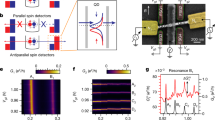Abstract
Near the interface between a normal metal and a superconductor, Cooper pairs penetrate into the normal side, giving rise to the proximity effect. The two electrons of these pairs have entangled spin and orbital degrees of freedom. Nonlocal features of quantum mechanics can be probed by separating these two electrons. This is achieved with a fork geometry with two normal leads containing either spin- or energy-selective filters. A signature of entanglement can be detected by measuring the positive noise cross-correlations in this fork. In the case of energy filters, Bell-inequality checks constitute a definite probe of entanglement. We formulate Bell-type inequalities in terms of current-current cross-correlations associated with contacts with varying magnetization orientations. We find maximal violation (as in photons) when a superconductor is the particle source.
Similar content being viewed by others
References
A Einstein, B Podolsky and N Rosen, Phys. Rev. 47, 777 (1935)
A Aspect, P Grangier and G Roger, Phys. Rev. Lett. 47, 460 (1981)
A Aspect, J Dalibard and G Roger, Phys. Rev. Lett. 49, 1804 (1982)
D Bouwmeester, A Ekert and A Zeilinger, The physics of quantum information: Quantum cryptography, quantum teleportation, quantum computations (Springer-Verlag, Berlin, 2000)
P Recher, E V Sukhorukov and D Loss, Phys. Rev. B63, 165314 (2001)
J Torrès and T Martin, Europhys. J. B12, 319 (1999)
M J M de Jong and C W J Beenakker, Phys. Rev. B49, 16070 (1994)
B A Muzykantskii and D E Khmelnitskii, Phys. Rev. 50, 3982 (1994)
M P Anantaram and S Datta, Phys. Rev. 53, 16390 (1996)
G Lesovik, T Martin and J Torrès, Phys. Rev. 60, 11935 (1999)
G Blatter, N Chtchelkatchev, G B Lesovik and T Martin, cond-mat/0112094
J S Bell, Physics (Long Island City, N.Y.) 1, 195 (1965)
J S Bell, Rev. Mod. Phys. 38, 447 (1966)
G B Lesovik, T Martin and G Blatter, Europhys. J. B24, 287 (2001)
D Feinberg, T Martin and O Sauret, cond-mat/0203215
Author information
Authors and Affiliations
Rights and permissions
About this article
Cite this article
Martin, T., Lovarco, C. Electron entanglement near a superconductor and bell inequalities. Pramana - J Phys 59, 279–287 (2002). https://doi.org/10.1007/s12043-002-0118-0
Issue Date:
DOI: https://doi.org/10.1007/s12043-002-0118-0




